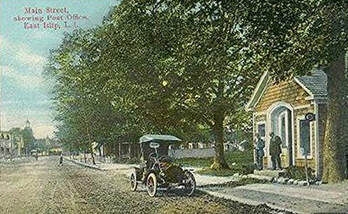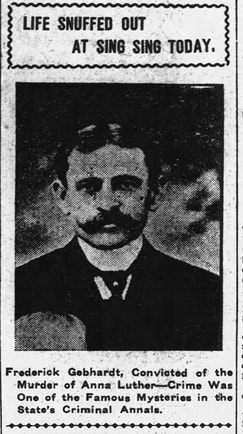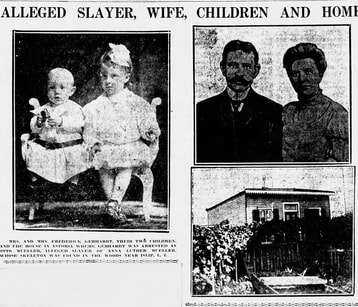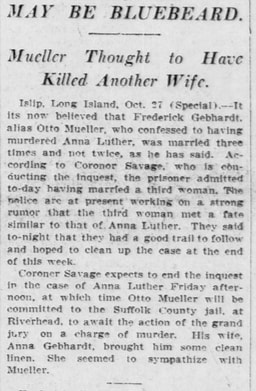 By M.P. Pellicer | Stranger Than Fiction Stories A skeleton was discovered on October 17, 1909 in a lonely spot in the woods two miles north of Islip, Long Island by rabbit hunters. There was no flesh on the bones, which gave evidence it had lain there for a long time. They were also charred from a forest fire that occurred in the area months before.  Prince St., Newark, NJ c.1905 Prince St., Newark, NJ c.1905 October 19, 1909 Islip, Long Island The clothing was in pieces, and the leg bones with the shoes still on lay about twenty feet away. One of the bones showed signs of having been chewed by some animal. The clothing was a black dress and coat, a man's black silk muffler which was tied about the neck of the skeleton. The ribs were encased in a black silk corset. The clothing was foreign made, but of good quality. In the pocket of the coat was a bill with a postmark of Kafeld, Rhinish Prussia. This was the only clue the authorities initially found upon discovering the remains. She had a gold neck chain with a heart-shaped locket set with diamonds, and a pendant made from a fresh water pearl. On the left wrist was also a gold chain with a pearl setting. A silver thimble, a hatpin and several hairpins were found. The body lay near the corner of two intersecting roads designated as Broadway and 28th Street, but they were seldom used, which accounted as to why the body lay there so long without being found. She was blond, judging by a thick mass of ribbon-tied hair found with the skull. It was still in a bow leading to the belief she was young. Her teeth had been filled with gold, and appeared to have been well cared for.  Dr. William Savage acted as the coroner in Islip and handled the Annie Luther case Dr. William Savage acted as the coroner in Islip and handled the Annie Luther case Once the word got out of the discovery the police received different leads pertaining to women that had gone missing. But as they found out more about the victim, they were able to eliminate them. The coroner who returned to the scene of where the skeleton was discovered, found a .32 caliber where the skull had lain. A further examination of the remains found a hole under the left ear that might have been made by a bullet. It seemed a bullet had passed through her throat severing the esophagus and lodging inside the head where it remained until decomposition dislodged it. This was considered a strange shot, and it was suspected she was shot while in an automobile. No revolver was found at the scene putting in doubt the theory of suicide. Near the skeleton was found an automobile veil of tan chiffon silk, catch-stitched at the edges. Robbery as a motive was discounted since the jewelry had not been taken, including a gold watch on a fleur-de-lis pin, a snake bracelet of a peculiar design and a necklace of gold and pearls. Inside the case of the watch the initials "A.L." had been scratched with the date "1893". Coroner Savage confirmed that the clothing she was wearing was expensive, and her black silk corset was made to order, and cost $50. Later it was determined that Annie Luther was given much of her expensive clothing from the rich women she had worked for through the years. The bones were taken to Daily's morgue, and in the meantime the German Consul-General was brought into the case. The bill that was found in her pocket was issued in Krebel, a town of Prussia. There was also a guide book issued by the Hamburg-American Steamship Company.  Frederick Gebhardt, used several aliases, and no one was sure that Gebhardt was his real name Frederick Gebhardt, used several aliases, and no one was sure that Gebhardt was his real name Within a week of the discovery the Hamburg police cabled information that the victim was probably Anna Latter of Altona, a suburb of Hamburg. Later this surname was corrected to Luther. The police then started hunting for Otto Mueller who was said to have married her on February 6, 1908 in Newark, N.J. In the months leading up to the wedding she had been employed as a maid in the home of Isaac Seligman, a New York banker for two years. She was described as a pretty girl who worked as a maid for wealthy families in Denver, Chicago and New York. Annie Luther had met her future husband at Far Rockaway Beach while she was caring for an invalid there. He introduced himself as an architect, and said he owned 12 lots in Jamaica, Long Island where he planned to build a house. The authorities found a witness to the wedding named Mrs. Henry Werpupp. She and her husband were to become instrumental in identifying the culprit. Shortly after the wedding Mueller took his bride to Europe where they visited her relatives. Then they returned to New York and spent a few days in Newark visiting friends. Suddenly the couple were lost track of, however the mystery of their disappearance was soon forgotten. Police eventually ran down Mueller's home in Astoria. Police found Regina von Miller, who was one of Mueller's wives. She recounted how she believed her husband was in the habit of escorting women to lonely parts of Long Island, for the purpose of forcing them to part with their money. She owned considerable property, and was in partnership with her brother George where they ran a barber supply business. She admitted that she believed her husband had been after her money when they married, and that he disappeared six months after the ceremony. She told police he got $2,200 from her while they lived together, and when she refused to give him anymore he abandoned her. He told her he was of noble birth, and that he received degrees in law and medicine in Germany. Two other women informed the police they were courted by a German, whose description answered that of Otto Mueller or von Miller as he was also known.  Frederick Gebhardt with his wife and children Frederick Gebhardt with his wife and children The police found Otto Mueller working as a grocery clerk at 681 Wythe Ave, Brooklyn. Eventually he admitted he killed Anna because he wanted to get rid of her and return to his wife. The authorities now wondered if Mueller had married different women, and then murdered them as well. He was taken to the station on Mulberry Street, Manhattan where he was given the "third degree." Marie Kramer a trained nurse, Mrs. Henry Werpupp and Mary Duckhausen all from Newark who were present at the wedding positively identified him. Then Mueller recanted and said he had left Anna in a flat in Manhattan, and went abroad to visit relatives, but found her gone when he returned. Police found that he had married another woman in Manhattan in February 1905, and left her with two children. Then they located another woman, also from Manhattan who had married him but he had deserted her after taking $2,700. During his last marriage he was using the name Fred Gebhardt. Mrs. Gebhardt told police that after she had given birth to two children, one day a woman came to her and said: "Your husband has put seven wives in their graves. You better watch out or he will have you there." She said he had left the family in February, 1908 without any money. She then received letters from Germany, and when he landed in the country he came back to live with them. Three trunks were delivered, many which contained expensive clothing, and books inscribed with the name Anna Luther inside. Mueller burned the letters, and erased the name in the books or tore out the fly leaves. The woman who had told her that her husband had buried seven wives, said his first wife went on to marry Richard Minzer, who was Gebhardt's partner in a real estate business. This was Gebhardt's confession: About December, 1907, I first met Anna Luther. We were married in February, 1908 and went to Europe to live. We returned April 6, 1908. She went to Henry Werpupp's in Newark, NJ to spend a day or two. On the pretense that I was going to rent an apartment for us to live in, I returned to my home and wife in Astoria. I met Anna again on April 1, in Newark and we went to an address in 34th Street, New York and then to Jamaica, Long Island, where we stayed until the next day.  It remained a mystery if Frederick Gebhardt had married and killed other women It remained a mystery if Frederick Gebhardt had married and killed other women Police had been able to find him by tracing two police dogs he brought from Germany. But in reality it was a stroke of good luck for the police, and bad luck for the fugitive. A newspaper photographer used a flash when photographing the dogs. The flare revealed the pale face of Gebhardt peering from the chinks of an outhouse. He was run down and arrested. In November, 1909, Warden Fury of the county jail received an anonymous letter written in German. The letter declared that Gebhardt's real name was Fritz Schaferlein. The writer declared that on September 15, 1895 Schaferlein married a woman whose name was not given. He sailed from Germany with her on the steamer Kensington. He got all her money and then deserted her. If this was true or not, it wasn't proven. Murder was a more serious affair than desertion, and the D.A. poured their efforts into proving the case against him. By October, 1910, Gebhardt was convicted of murdering Anna Luther and was sentenced to death the week of December 5. On June 12, 1911 after losing his appeals Frederick Gebhardt was executed at Sing Sing's electric chair. Anna was buried on June 26, 1911 in Oakwood Cemetery. The D.A. had kept her remains until after Gebhardt's execution. Aside from the undertaker and his assistant, the only other person present at the burial was Henry Werpupp. There was no ceremony of any kind. She was buried on her 30th birthday. Originally her remains were to be cremated and sent to her family in Germany, but they decided to bury her in the United States instead. Mr. Werpupp was to keep her belongings until her father could come the following year from Germany to pick them up. Sources - New York Tribune, Brooklyn Times Union, The Buffalo Enquirer, The Brooklyn Daily Eagle, The Central New Jersey Home News
0 Comments
Your comment will be posted after it is approved.
Leave a Reply. |
Stranger Than Fiction StoriesM.P. PellicerAuthor, Narrator and Producer Archives
July 2024
Categories
All
|
Stories of the Supernatural
- Stories of the Supernatural
- Miami Ghost Chronicles
- M.P. Pellicer | Author
- Stranger Than Fiction Stories
- Eerie News
- Supernatural Storytime
-
Astrology Today
- Tarot
- Horoscope
- Zodiac
-
Haunted Places
- Animal Hauntings
- Belleview Biltmore Hotel
- Bobby Mackey's Honky Tonk
- Brookdale Lodge
- Chacachacare Island
- Coral Castle
- Drayton Hall Plantation
- Jonathan Dickinson State Park
- Kreischer Mansion
- Miami Biltmore Hotel
- Miami Forgotten Properties
- Myrtles Plantation
- Pinewood Cemetery
- Rolling Hills Asylum
- St. Ann's Retreat
- Stranahan Cromartie House
- The Devil Tree
- Trans-Allegheny Lunatic Asylum
- West Virginia Penitentiary
- Paranormal Podcasts
"When misguided public opinion honors what is despicable and despises what is honorable, punishes virtue and rewards vice, encourages what is harmful and discourages what is useful, applauds falsehood and smothers truth under indifference or insult, a nation turns its back on progress and can be restored only by the terrible lessons of catastrophe."
- Frederic Bastiat
- Frederic Bastiat

Copyright © 2009-2024 Eleventh Hour LLC. All Rights Reserved ®
DISCLAIMER
DISCLAIMER
 RSS Feed
RSS Feed
















